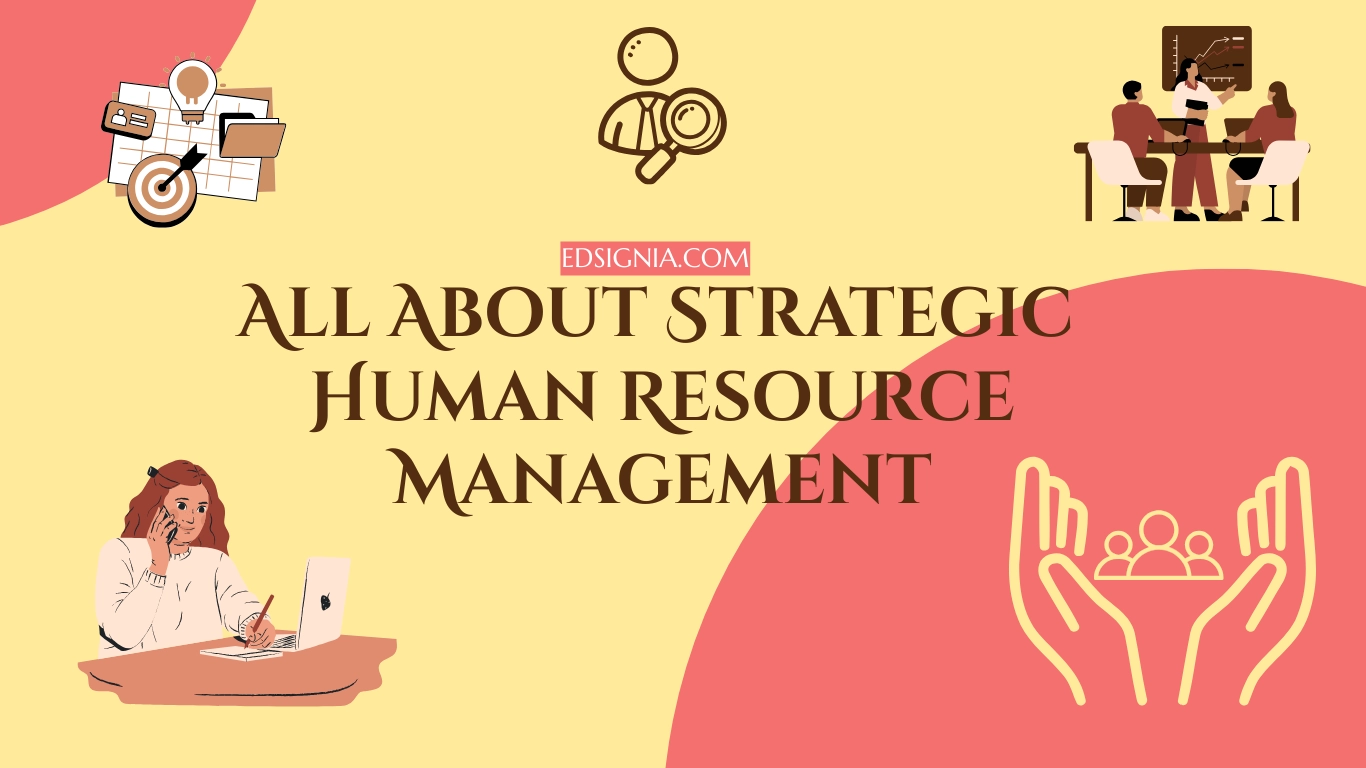Introduction
Before undertaking any new initiative by a business firm, it is essential to properly manage the human resources. There is a common misconception that after the initial recruitment of employees, the role of HR is complete. Hiring the right candidates for the right position is just the beginning of the long drawn strategic human resource management process.
Strategic human resource management (SHRM) is a modern shift from traditional human resource practices. SHRM is an employee centric approach where the organisation believes that human capital is the most important asset. This realisation enables the company to work closely with their employees for the fulfillment of organisational goals.
We will be taking a look at the different components of SHRM and some examples in real life scenarios. Let us dive right into it and find what makes strategic human resource management such an important part of modern day management.
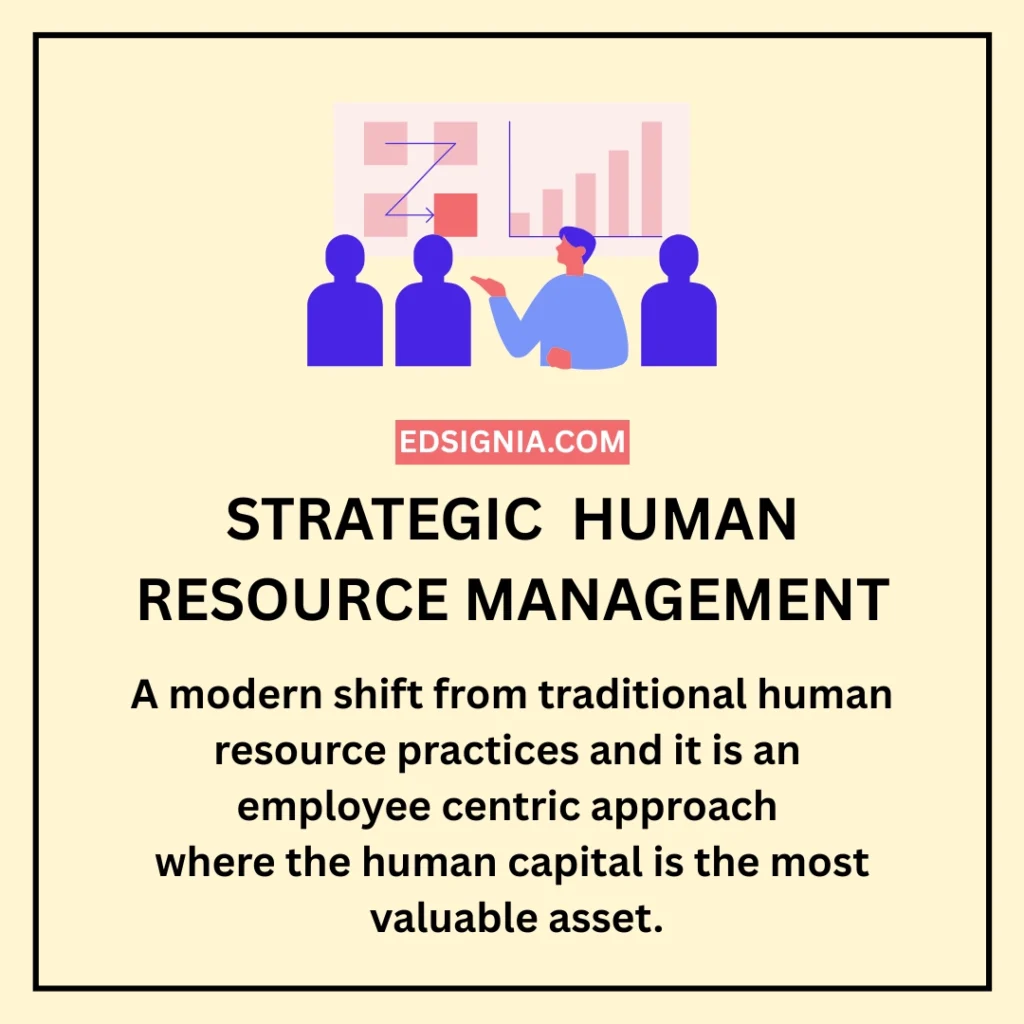
Strategic HRM Process
There are multiple factors which go into the creation of an efficient and effective strategic human resource management process. They are responsible for ensuring the plan will work when it is implemented and face least resistance from the workforce as well as from the higher management. The major function of a strategic HRM process is to increase outputs while simultaneously assisting each and every employee to reach their maximum potential.
Assessing Workforce Requirements
The first step of a strategic human resource management is to identify the workforce requirements. To do this, the business firm has to first look at the employees they currently have. After this, they have to look at organisational goals, current employee skill set, and to hire more manpower for meeting the predetermined objectives.
After looking at the complete picture, including the current manpower, organisational objectives, and the projected growth figures, a firm can start the recruitment process. Collecting data is the first step of the strategic HR management process. This helps the business firm in undertaking major staffing decisions with objective data to back it up.
Ideation Stage for HR Strategies
The next step in the strategic HR process is known as the ideation phase. In this stage, different HR managers work together to formulate the best course of action for the company. They brainstorm different ideas and plans to integrate the needs of the employees with the needs of the business firm.
A little back and forth and a few emails and round conference meetings later, a plan is created. This plan is then presented to the business firm and after a few adjustments later, it is implemented in the organisation. Creation of a suitable course of action is only half the work and the main task is to successfully implement it without facing resistance from the workforce.
Implementation Phase for HR Strategies
The biggest hurdle for any HR strategy is its successful implementation. There will generally be two groups within a business firm who will have different opinions regarding the new course of action. The first group will welcome the change while the second group will be resistant to it and prefer the traditional way of doing things.
A good HR manager will take the opinions of both groups into consideration. After doing this, they will have a meeting with the latter group and address their grievances while answering most of the questions. This fosters a sense of understanding and allows for a successful implementation of the new HR strategy.
Controlling Strategic Deviations
Now, a different obstacle awaits the HR managers and that is the deviations which may arise after the implementation of a new human resource plan. The best way to go about this is to compare the previous plan with the latest one. A manager can check what worked previously and what is not working in the current strategic plan.
Comparing the results of the set standards with the actual performance can help the HR manager in correcting deviation at the earliest. This can be achieved by making adjustments in the initial strategy which was formulated. HR managers can also choose to consult other experts within the business firm and seek their guidance on how to tailor the strategic plan to fit the needs of the workforce.
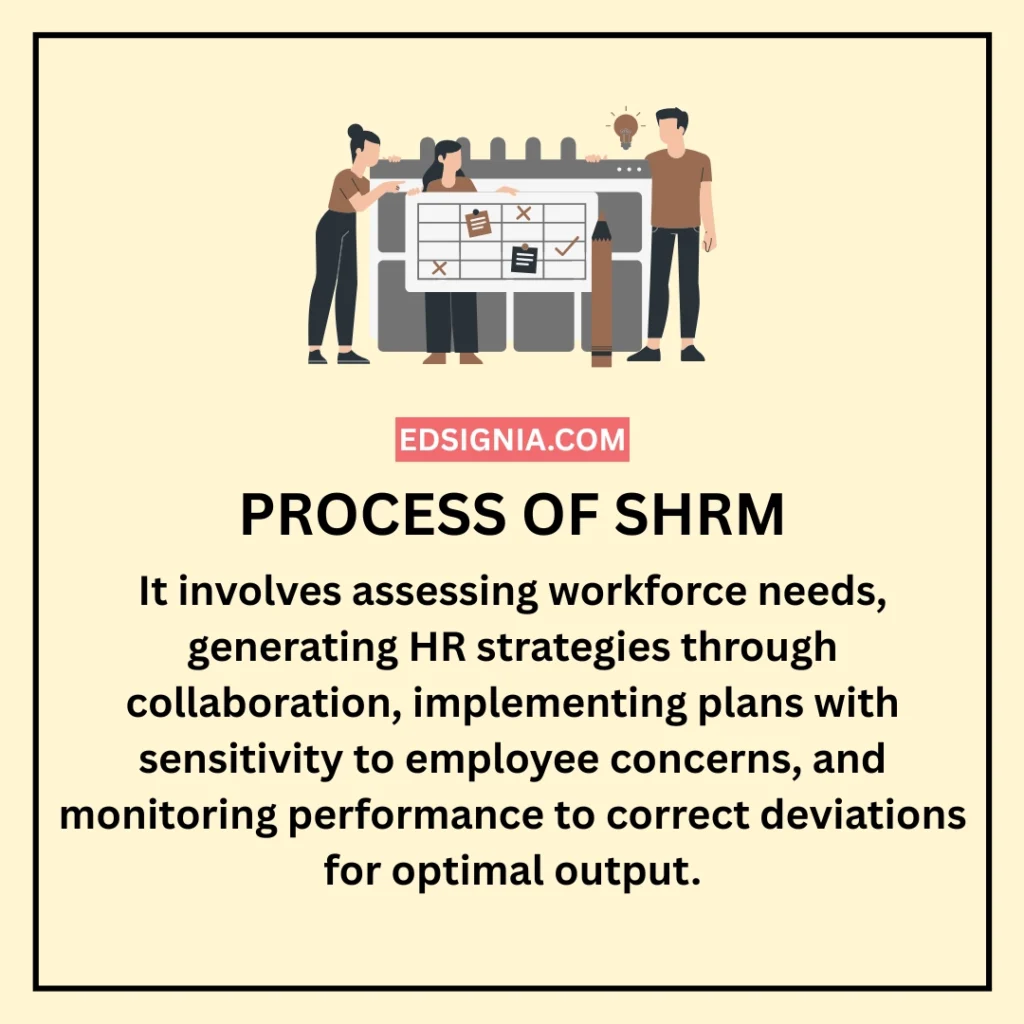
Components of Strategic HRM
There are four primary components of a strategic human resource management plan. They are concerned with finding the right person for the right job. After meeting the workforce requirements, the goal then shifts to retain the employees and provide training and guidance to them. Doing so will create a positive work environment and allow for maintaining positive employee-employer relations.
Recruitment and Selection
Finding the right person for the right job remains the fundamental problem for an HR manager to solve. The primary component of strategic HR management is to create a recruitment process which allows for selecting a skilled individual. For doing this, the HR has to ensure that a candidate possesses not just academic skills but other fundamental human skills as well.
A multifaceted recruitment process follows which evaluates different behavioural traits of an individual. These traits include emotional maturity, ability to resolve conflicts, anger management, and other such core human skills. This allows for the selection of a candidate who is both intellectually sound and has a personality which meshes well with the company.
Training and Development
After employee acquisition is completed, the next stage begins which deals with employee training. It is done to make the talent recognise the work requirements of the workplace and what is expected from their end. The HR manager may give a guidebook or personally mentor the staff to make them familiar with the organisation.
There are multiple components of the training process such as on-the-job training, off-the-job training, mentorship, and guided lessons. The exact training method will vary from company to company but the goal remains the same. The goal is to enhance the employee skill level and help them adapt to the new environment in the least amount of time.
Performance Evaluation
After an employee’s training is completed and they have worked for a good amount of time, the next goal of HR is to evaluate their performance. Oftentimes, it is assumed that performance evaluation is a test where the main focus is on determining employee’s productivity. It cannot be any further from the truth because productivity assessment is a very small part of the whole process.
Performance evaluation allows the HR managers to find the ones who are performing well and help the ones who are not doing so well. The goal of an HR manager is a holistic one where they provide assistance and solve challenges which impairs the performance of employees. This, in turn helps to bridge the performance gaps and allows the employees to overcome hurdles they were facing.
Managing Employee Relations
In the process of strategic human resource management, maintaining employee relations is the main objective. The HR manager is tasked with the responsibility to bridge the gap and act as a medium of communication between the employees and the employers. In any business firm, maintaining healthy employee-employer relations is fundamental for achieving business goals.
When the high level management has to convey an important decision or a change in policy, the human resource department acts as a middleman for facilitating changes.
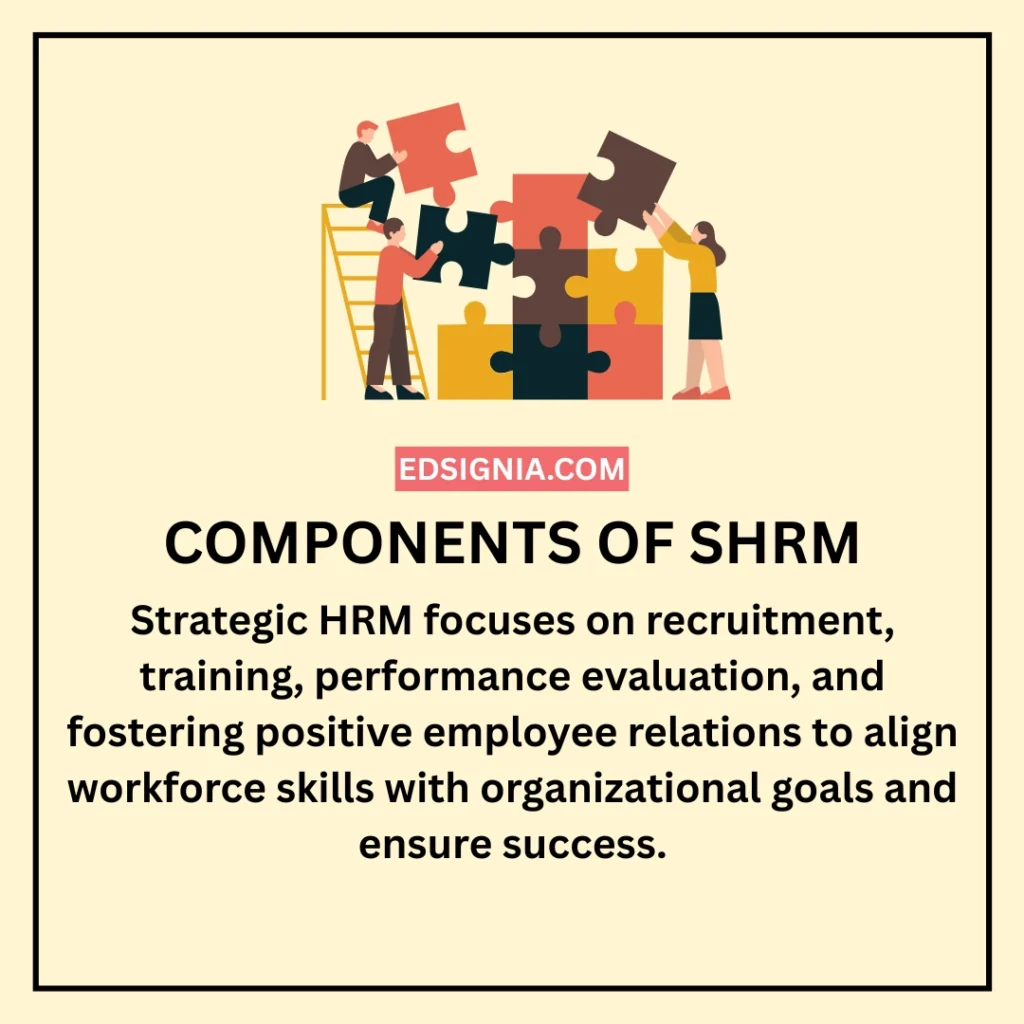
Objectives and Importance
There are several different measures to assess the impact of any managerial plan. For SHRM, there are a number of objectives it has to accomplish. These objectives range from increasing competitive advantage to retaining talented personnel for the business firm. Some of these objectives are as follows.
Provides Competitive Advantage
The major benefit of implementing SHRM policies is to get an upper hand over the competition. If an HR manager is able to bridge the gap between the management and the employees, it allows for smoother functioning. This is because in any social environment, successful results can only be accomplished if there is harmony and a feeling of cooperativeness among the people.
Successful implementation of strategic human resource management policies makes a business firm stand head and shoulders ahead of their competition. Higher employee satisfaction leads to lower workforce resistance and makes way for working together. As a result, different departments such as production, marketing, and finance cooperate for achieving organizational goals in a time bound manner.
Increases Organisational Efficiency
Some may argue that the biggest benefit of Strategic HRM policies is to increase the efficiency of the firm and they would be right. A business runs by completing their tasks on schedule and if they go off track, their efficiency and brand goodwill will suffer. This means that they have to continuously perform at a good level and take immediate corrective actions whenever deviations are found.
Strategic HRM allows the employees and management to work hand in hand to tackle uncertainties which may arise during operations. Suppose a manufacturing unit starts malfunctioning during operational hours and a replacement is urgently required. In such a case, the financial department will contact the supplier and reach an immediate agreement for the purchase of a replacement.
Reduces Resistance to Change
In a company, change is a regular part of daily operations. The change may be in operations, or managerial activities, or for HR policies. This is done to reduce rigidity and ensure that the workplace can adapt to the changing needs of the market.
In a firm which adopts strategic HR policies, the human resource department can reduce resistance to change by adopting various methods. They can choose to set up personal meetings to inform the employees, address their grievances, and listen to their feedback. A combination of these is essential for ensuring that a business organization keeps functioning optimally.
Talent Acquisition and Retention
After employee hiring, the human resource department has to formulate ways to ensure that the employee keeps working for their firm for a longer tenure. This is essential because finding a competent employee and training them according to organisational goals uses a ton of resources. When all of this is completed, the business firm gets a net addition in the form of a skilled and competent employee.
Retaining them after training is completed is a major challenge. When the strategic HR policies are utilized efficiently, employee retention becomes smooth sailing. This is because the employee feels that they are being valued by the firm through means of being given incentives and recognized by the management.
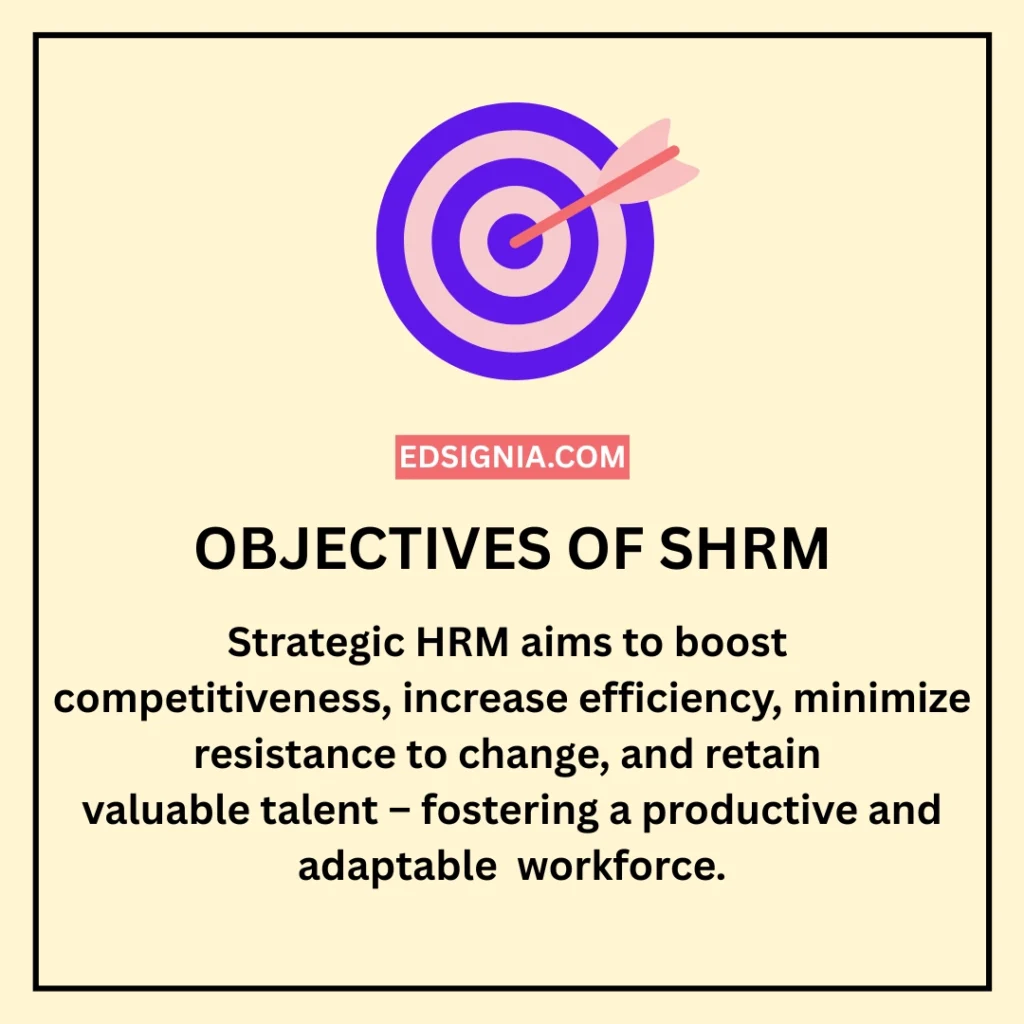
Issues and Challenges
As with every major managerial strategy, SHRM is not any different. With all the benefits it provides, there are certain limitations as well. Let us identify these issues and challenges and find out how they can make implementation of strategic human resource policies difficult.
Increased Training Cost
There is a popular saying which goes like, “There is no free lunch”. It implies that even when something appears to be free without an upfront cost, there would be hidden charges. This theory applies very well to strategic human resource policies.
The human resource department has to train their HR managers to impart them with the skills required for performing SHRM policies. It will cost both time and resources to the firm and the HR would expect to be compensated as well. If the firm faces a budget constraint, they may choose to not opt for implementing strategic HR management policies.
Difficulty in Implementation
In a corporate environment, unforeseen circumstances may arrive which could lead to pivoting from the main course of action. These challenges can range from an economic recession to the arrival of a new competing business firm. During such instances, it becomes a mammoth task to implement strategic HRM policies.
There could be another roadblock as well which is the “lack of will” by the business unit to implement new policies. This can occur due to reluctance to adopt a new policy framework or refusal to accept the increased expenditure. Regardless of the reasons, these challenges are major hurdles which come in the way of successful implementation of SHRM policies.
Lack of Uniformity
For most of the management policies, there is a predefined guideline or a set framework which informs the manager on how to conduct their different managerial duties. The same cannot be said for SHRM policies as they lack a uniform set of guidelines to follow. Strategic human resource management is a modern approach which does not adopt a stringent framework.
SHRM policies allow flexibility to the human resource management of a firm to fine tune it to fit their organisational framework better. Even though this method is apt for tackling modern HR challenges, it also poses a major challenge in itself. Due to this, choosing a set of policies for SHRM practices may be an issue which limits its adoption.
May Hinder Innovation
The main point of contention of strategic HR management policy is the indirect channel of communication. When an employee has a new idea, they would have to go through an indirect channel of communication. This may deter an employee from taking the first step.
There are methods to address this by employing a distinct communication channel such as using email or fax. The company can also set up meetings between the executives from different departments and the employees to enable them to discuss future plans and new ideas. However, it can be a challenge in itself and it wouldn’t be wrong to say that SHRM policies may disrupt innovation.
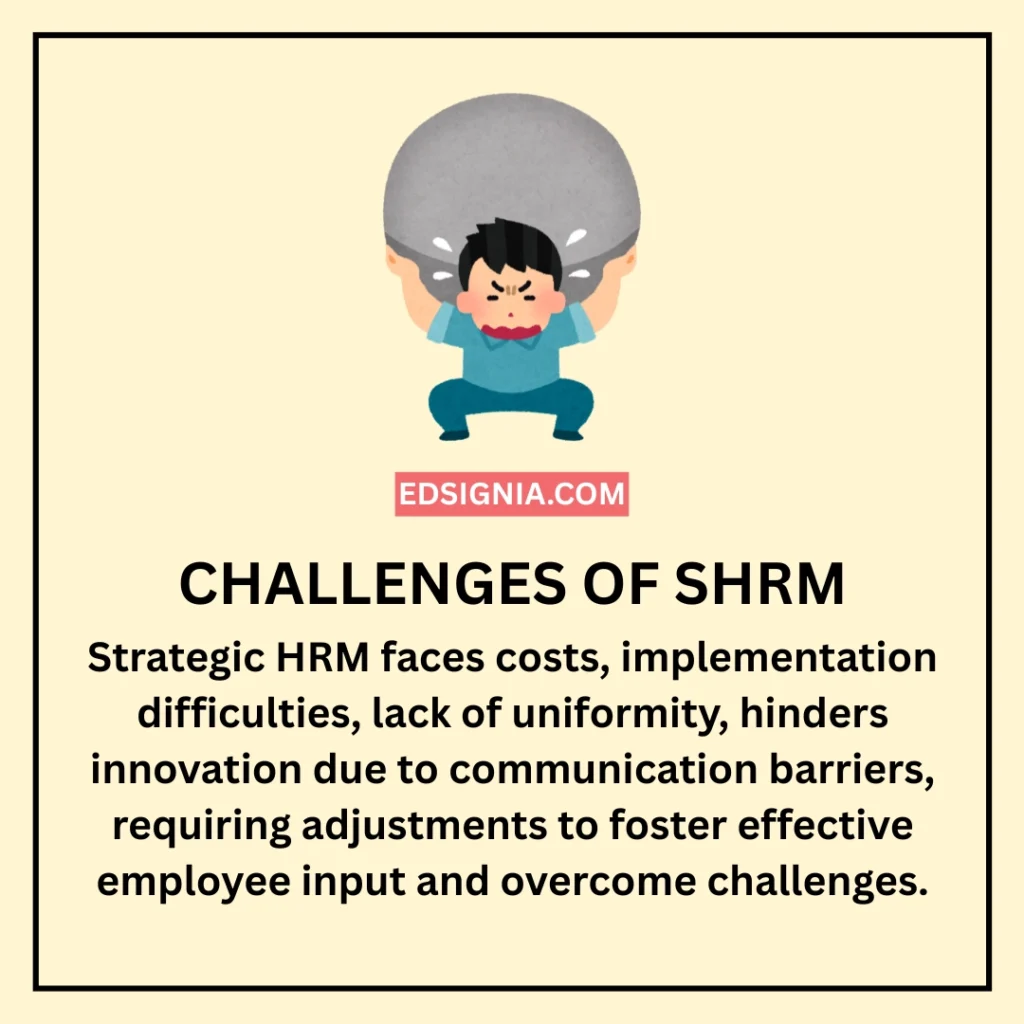
Real Life Examples of SHRM Practices
We took a look at the theoretical concepts which involve strategic human resource management but no theory is complete unless it has been successfully implemented in practice. Strategic HRM is a modern management practice which has been adopted by several organizations across different countries. Let’s take a closer look at some examples and the benefits SHRM policies have yielded.
“Will” Method
In Japan, there is a semiconductor manufacturing company called Disco Corp which has adopted an innovative approach that can be termed as an example of strategic HRM practice. They have implemented a concept named “Will”. This will is of monetary value and it also acts as a determinant for deciding employee bonuses and incentives.
Every month, an employee starts with a zero “will” balance and with good performance, they will earn more “will” points. This initiative helps to form a work environment where the employee is seen as a stakeholder in the firm. As a result, it enhances employee’s motivation and increases productivity without overburdening them.
The Kaizen Way
The next entry on our list of SHRM practices in the real world is Toyota, which is an automotive manufacturer situated in Japan. It adopts a method known as the “Kaizen” way where the employees are motivated to share ideas and provide suggestions to the entire team. The Kaizen method also suggests that there is always room for improvement.
This facilitates discussion among team members and provides different viewpoints to make problem solving easier. The Kaizen approach enables the firm to provide timely delivery and maintain a harmonious environment within the organisation. As a result, the firm operates in a creative manner instead of a monotonous one.
Work Life Balance
From the big name players, Google is one which is remarkably known for their strong emphasis on strategic HRM practices. They provide flexible working hours, meal arrangements, fitness facilities, among other such facilities to make a creative work environment. Their quarterly profits are one fine example of how good HR management practices yield dividends.
Google does all this to foster creativity within the workspace and make employee retention a seamless process. They try to make the workplace an extension of their employee’s lives and this seems to be the reason for the availability of fooding, custom workplace design, and fitness facilities. In doing so, they encourage both collaboration as well as innovation.
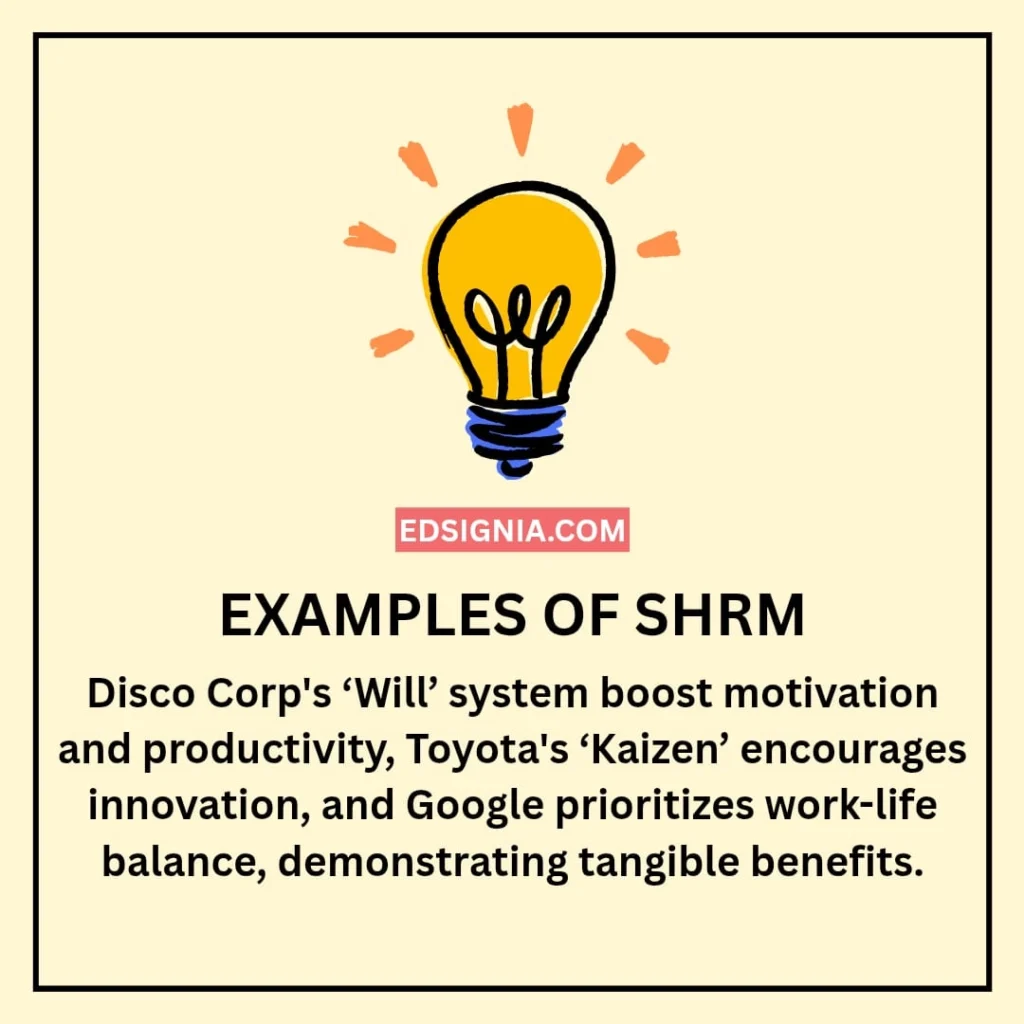
Conclusion
This was a long piece and if you are still reading, I hope it answered most of your queries you had about strategic human resource management. We took a close look at the process, components, importance and limitations of Strategic HRM. Along with them, we also tried listing the real world examples of strategic human resource management policies.
Strategic HR management is widely being adopted by modern business firms. To demonstrate this, we also tried to cover the different methods companies utilize to integrate such policies in their day-to-day business operations. Some of the methods we looked at were “Kaizen way”, “Will method” and “Work life balance with perks”.
Employing smart and tactical human resource policies can give a competitive edge to businesses and help them with employee retention and management. A well developed strategic HRM policy perfectly tackles the challenges and provides ways to increase output of the firm. If you have any questions, feel free to drop them in the comments down below.
You can also give suggestions for new article ideas by visiting our Contact page or read a similar piece on “Conflict of Interest” we recently published. Hoping to hear from you soon with another informative piece on the way.

